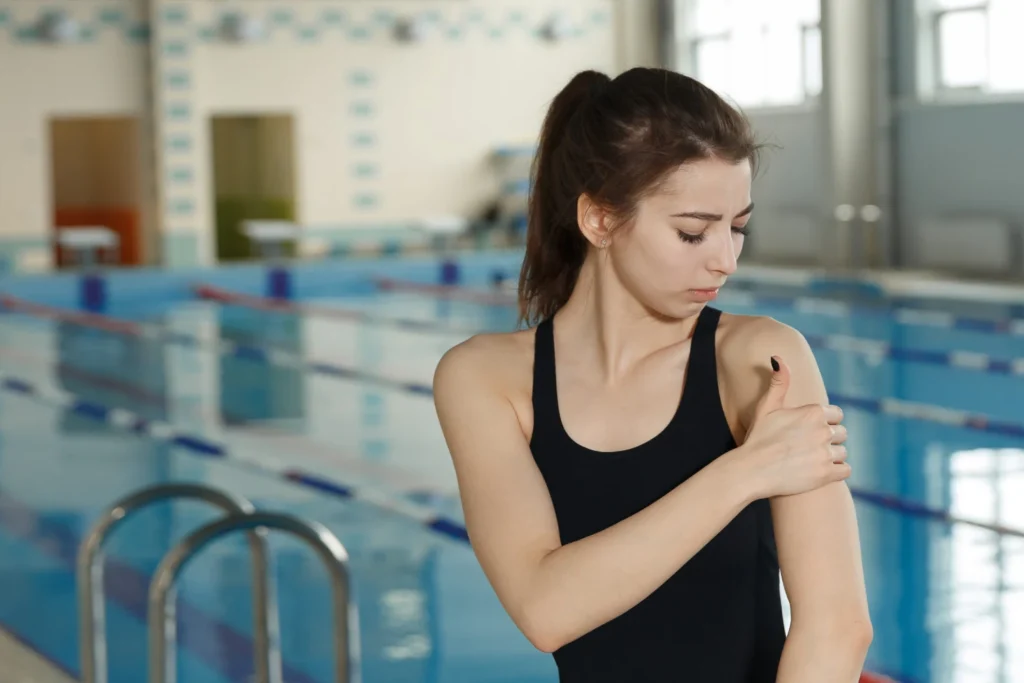Feeling a nagging ache in your shoulder after swimming? You’re not alone. That pain, often called swimmer’s shoulder, is like an unwanted badge of the sport. It’s what happens when the same arm motion, lap after lap, starts taking a toll on your shoulder, leading to soreness, stiffness, and sometimes even sharp pain.
But here’s the good news: there are ways to fix it, and you don’t have to give up swimming. In this blog, we’ll dive into what causes swimmer’s shoulder, how to spot it, and, most importantly, easy stretches and exercises that can help you get back in the water pain-free.
Ready to tackle swimmer’s shoulder head-on and keep doing what you love? Let’s jump in and explore how to make your shoulders strong and flexible, ready for every swim.
Contents
Understanding Swimmer’s Shoulder
Swimmer’s shoulder is a common issue that plagues many swimmers, from casual enthusiasts to competitive athletes. It’s essentially an overuse injury affecting the shoulder’s tendons and muscles, leading to discomfort and pain. The main culprit? Repetitive swimming motions, especially those that involve overhead movements like the freestyle, butterfly, and backstroke.
Causes
- Continuous, repetitive arm movements in swimming can put a strain on the shoulder’s soft tissues
- Incorrect swimming form can increase the stress on the shoulder, contributing to the development of swimmer’s shoulder.
- Not allowing enough recovery time between swimming sessions can exacerbate shoulder wear and tear.
- Weak muscles around the shoulder and upper body can lead to an imbalance, putting more strain on certain parts of the shoulder.
Symptoms
- dull ache or sharp pain in the shoulder
- stiff shoulder, making it difficult to perform usual swimming motions or even daily activities.
- Swelling and tenderness
- weakness in the shoulder, affecting swimming performance or the ability to carry objects.
Understanding swimmer’s shoulder is crucial for early detection and intervention. Recognizing these causes and symptoms not only helps in seeking timely treatment but also plays a significant role in preventing the condition from worsening.
What is the Fastest Way to Fix Swimmer’s Shoulder?
 The fastest way to address swimmer’s shoulder involves a combination of rest, targeted exercises, and proper technique adjustments. While there’s no overnight cure, these strategies can significantly speed up recovery and prevent future injuries. Here’s how to tackle swimmer’s shoulder effectively and get back to swimming:
The fastest way to address swimmer’s shoulder involves a combination of rest, targeted exercises, and proper technique adjustments. While there’s no overnight cure, these strategies can significantly speed up recovery and prevent future injuries. Here’s how to tackle swimmer’s shoulder effectively and get back to swimming:
- Reduce or take a break from swimming activities that exacerbate shoulder pain.
- Use an ice pack for 15-20 minutes several times a day, especially after any activity that might strain the shoulder.
- Consult a physical therapist who can provide a set of exercises specifically designed for your condition
- Work with a swimming coach to ensure your swi mming technique is correct.
- Once your shoulder starts to feel better, gradually reintroduce swimming into your routine, starting with low-intensity sessions and slowly building up.
- Incorporate shoulder-strengthening and flexibility exercises into your regular training routine, even after your shoulder has healed, to prevent re-injury.
- Consider using swim gear like paddles or fins judiciously, as they can increase the strain on your shoulders.
Fast recovery from swimmer’s shoulder is about balancing rest and rehabilitation. By following these steps and listening to your body, you can heal your shoulder and return to swimming stronger and more resilient.
Stretching Exercises for Swimmer’s Shoulder Relief
Incorporating specific stretches into your routine can offer significant relief from swimmer’s shoulder by targeting tension in the muscles and tendons around the shoulder. Here are some essential stretches, each aimed at enhancing flexibility and reducing discomfort:
Pendulum Stretch

- Stand and lean over slightly, allowing the affected arm to hang down.
- Gently swing your arm in small circles in one direction, then reverse.
- This stretch helps loosen the shoulder joint and relieve tension.
Across-the-Chest Stretch

- Bring one arm across your body at about chest height.
- Use the other hand to press the arm closer to your chest until you feel a stretch in the back of your shoulder.
- Hold for 15-30 seconds and switch arms. This targets the posterior shoulder muscles.
Doorway Stretch

- Stand in a doorway and place your arms on the door frame, elbows at a 90-degree angle.
- Gently step forward until you feel a stretch in the front of your shoulders and chest.
- This stretch opens up the chest and shoulders, counteracting the forward hunch that swimmers often develop.
Towel Shoulder Stretch

- Hold a towel in one hand and bring it over your shoulder.
- Reach behind your back with the other hand and grab the bottom end of the towel.
- Gently pull on the towel, moving your hands closer together. This stretches both the upper and lower parts of the shoulder.
Neck Release
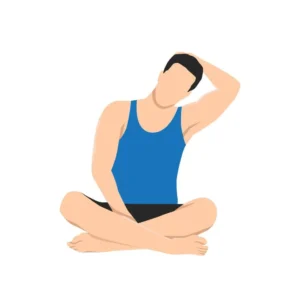
- Sit or stand with your back straight.
- Slowly tilt your head to one side, bringing your ear towards your shoulder until you feel a stretch on the opposite side of your neck.
- Hold for 15-30 seconds and switch sides. This helps relieve neck and upper shoulder tension that can contribute to swimmer’s shoulder.
Shoulder Blade Squeeze
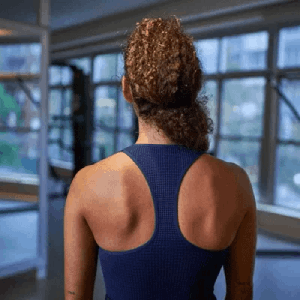
- Sit or stand with your arms by your sides.
- Squeeze your shoulder blades together as if trying to hold a pencil between them.
- Hold for 5 seconds and release. Repeat several times. This strengthens the back muscles and improves shoulder alignment.
Remember, these stretches should be performed gently and without forcing the movement. If any stretch increases your pain, stop immediately and consult with a healthcare professional. Incorporating these stretches regularly, especially after swimming, can help manage swimmer’s shoulder symptoms and improve your shoulder health.
Strengthening Exercises to Support Shoulder Health
Strengthening the muscles around your shoulder, upper back, and core is key to preventing and recovering from swimmer’s shoulder. These exercises, which can easily be done at home with minimal equipment, are designed to build the muscle support your shoulder needs for swimming and daily activities:
Wall Push-Ups
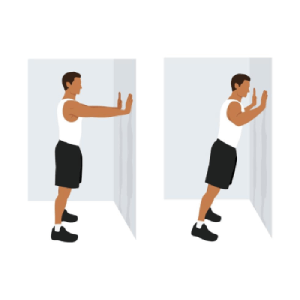
- Stand facing a wall, feet shoulder-width apart.
- Place your hands on the wall at shoulder height.
- Bend your elbows to bring your chest towards the wall, then push back to the starting position.
- This exercise strengthens the shoulder and chest muscles with less strain than floor push-ups.
Shoulder External Rotation
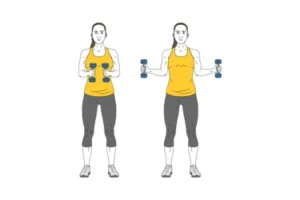
- Hold a light dumbbell or a resistance band in one hand, elbow at your side and bent to 90 degrees.
- Rotate your forearm outward, keeping your elbow pinned to your side, then return to the starting position.
- This targets the rotator cuff muscles, crucial for shoulder stability.
Plank
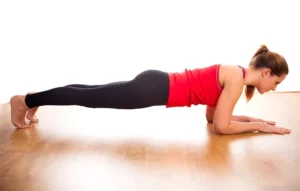
- Lie face down, then lift your body onto your toes and forearms, keeping your body in a straight line.
- Hold this position, engaging your core, for as long as you can.
- Planks strengthen the core and upper body, promoting better posture and reducing shoulder strain.
Reverse Fly

- Bend forward at the waist, holding a light dumbbell in each hand with palms facing each other.
- With a slight bend in the elbows, lift your arms out to the sides until they are parallel with the floor, then lower.
- This exercise strengthens the upper back and shoulders, helping to counteract forward hunching.
Scapular Wall Slides
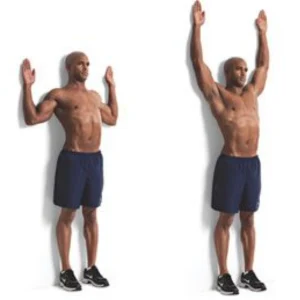
- Stand with your back to a wall, elbows and wrists against the wall and hands up (like signaling a touchdown).
- Slide your arms up the wall, keeping your elbows and wrists in contact, then slide them back down.
- This exercise works on scapular mobility and strength, important for shoulder health.
Prevention
Preventing swimmer’s shoulder is crucial for anyone who enjoys swimming regularly, whether for fitness, competition, or leisure. By taking proactive steps, you can help protect your shoulders from injury and ensure that swimming remains a positive and healthy part of your life.
- Before diving in, ensure you perform a thorough warm-up that includes dynamic stretches and movements to prepare your shoulders for the water.
- Regularly incorporate shoulder, upper back, and core strengthening exercises into your routine.
- Overuse of training equipment like paddles can increase strain on the shoulders.
- Use such tools judiciously, and focus on building strength and technique without overloading the joints.
- Pay attention to any signs of discomfort or pain in your shoulders. Don’t push through shoulder pain.
- Ensure you’re giving your body enough time to recover between swim sessions.
- Incorporate Activities like yoga, cycling, and running which can complement your swimming without overtaxing your shoulders.
- Ensure that your taking proper nutrition and hydration which can support muscle function and recovery.
By integrating these preventive measures into your swimming routine and overall lifestyle, you can enjoy the benefits of swimming while minimizing your risk of developing swimmer’s shoulder.
Conclusion
In wrapping up, while swimmer’s shoulder can be a setback, it doesn’t have to sideline your passion for swimming or compromise your daily activities. With the right approach to prevention, strengthening, and stretching, you can maintain healthy shoulders. But sometimes, despite our best efforts, pain and injuries can sneak up on us, signaling it’s time to seek professional help.
If you’re navigating through the discomfort of swimmer’s shoulder or any other pain, you don’t have to go through it alone. MantraCare is here to support you with an effective physical therapy plan tailored to your specific needs.
Physical Therapy helps patients recover from pain. If you’re experiencing Back pain, Shoulder pain, Knee pain, Neck pain, Elbow pain, Hip pain, or Arthritis pain, a physical therapist at MantraCare can help: Book a physiotherapy session.
FAQs
How Do You Diagnose Swimmer’s Shoulder?
Diagnosing swimmer’s shoulder typically involves a physical examination by a healthcare provider, who will assess your shoulder for pain, tenderness, and range of motion. They may also ask about your swimming habits, training intensity, and technique. In some cases, imaging tests like MRI or X-rays might be recommended to rule out other conditions or to get a clearer view of the shoulder’s condition.
What is the First Aid for Swimmer’s Shoulder?
First aid for swimmer’s shoulder involves immediate rest and ice application to reduce inflammation and pain. Avoid activities that exacerbate the shoulder pain, including swimming, until you’ve consulted with a healthcare professional. Gentle stretching and over-the-counter pain relievers can also help alleviate symptoms in the initial stages.
Can Swimmer’s Shoulder Be Cured?
Yes, swimmer’s shoulder can often be cured with the right approach. Most cases respond well to rest, physical therapy, and changes in swimming technique or training intensity. Early intervention and a tailored treatment plan are key to a full recovery, allowing many swimmers to return to their activities without lingering issues.
Does Swimmer’s Shoulder Need Surgery?
Surgery is rarely needed for swimmer’s shoulder. Most cases can be effectively managed with non-surgical treatments such as physical therapy, rest, ice, and anti-inflammatory medication. Surgery might be considered in severe cases where there’s significant structural damage that doesn’t respond to conservative treatments, but this is relatively uncommon.
